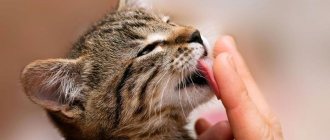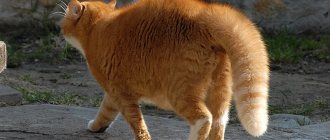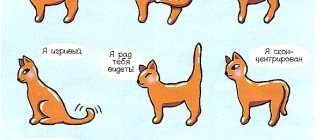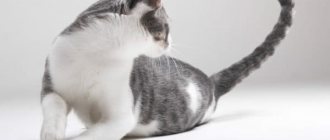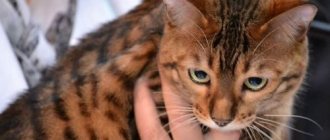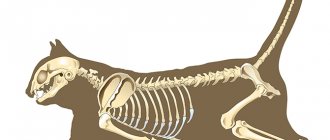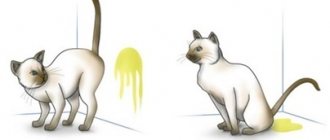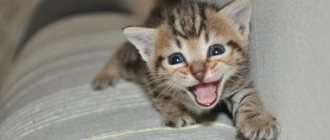There are a number of reasons why a cat shakes its tail, the most mobile part of its body. As an extension of the spine, the tail is equipped with a dense network of nerve fibers. Thanks to this, various movements are considered by a person as a kind of “language” of the pet and allow the owner to understand his cat. Unlike dogs, cats convey many emotions with their tail.
How cats communicate using their tail
In a cat society, the tail is simply irreplaceable. With the help of this part of the body, cats can express their attitude towards each other without uttering a sound.
Serious cat
The cat twitches its tail, and it is raised by a “pipe”
This is how the cat expresses pride in himself and his appearance. The cat feels confident in the circle of those present. Or the pet is very happy about the long-awaited meeting with the owners.
For your information! Showing self-confidence, cats can lick in front of unfamiliar animals and people.
The tip of the tail moves from side to side
This is how the animal shows curiosity, keen interest and some apprehension. This is usually how cats behave when meeting a new resident of the house.
Important! At the moment when the cat is excited, he is easily scared. Therefore, owners need to be careful not to frighten their pet. It is necessary to calm the kitten: pet it, scratch it.
If a cat looks around in fear and shakes its hooked tail, then something or someone is irritating it. Perhaps this is how the pussy tells its owner or pet that it does not intend to play or is not in the mood to communicate.
The fur on the tail is ruffled
In this situation, the cat is preparing to attack unexpectedly, so owners need to be vigilant. Perhaps, in this way, the cat is honing its hunting skills through play, or the pet is very irritated.
Annoyed cat
The cat's tail is shaking... in his sleep
You've probably seen your pet purring when he's taking a leisurely nap. Or maybe you've noticed that his body, including his whiskers, paws and tail are shaking. According to scientists, this may mean that your little predator is dreaming of something interesting, for example, chasing his favorite toy or... a mouse.
However, this is not the only possible reason. A moving tail when a cat appears to be dozing may mean that the cat is not sleeping at all, but is simply relaxing. However, he is still aware of what is happening around him. Most often this happens when the cat is resting near the window, and very interesting sounds are heard outside.
Source
Why do cats shake their tail?
Watching the cat, breeders wonder why the cat develops new behavioral characteristics - the tail is shaking. To give an accurate answer, you need to understand the details of this phenomenon.
The cat is coughing: why it wheezes, the reasons, as if it was choking
A restless cat holds his tail in a horizontal position. If a cat's tail occasionally trembles and he looks around in fear, with his ears pressed to his head, this indicates the animal's alertness. If there is an object of irritation in the room, then it should be removed from the cat’s field of view, otherwise the animal may panic, and the further outcome of the actions of a frightened animal is unpredictable.
Note! But if the tail sways from side to side, you need to be prepared for a sudden attack by your pet, however, such a command from a pet does not always foreshadow a threat. Similar habits can be observed while playing with an inanimate object. Cats, parading their ancestors, attack their toy.
Cats, like humans, can express doubt when they need to make a choice. Living for several thousand years side by side with people, the descendants of tigers began to adopt some of the habits of the supreme being. While in thought, a person can rhythmically tap his fingers on the table or swing his leg. Likewise, a cat, which is faced with a choice, begins to involuntarily twitch the tip of its tail; the pussy holds the base of the tail straight. Moreover, in such a situation, only the tail is involved, that is, no other peculiarities in the cat’s behavior are observed. To stop flinching, you just need to help your pet make a choice.
The cat also twitches its tail, expressing a feeling of satisfaction. When the cat is calm, fed, and happy, he slowly raises the tip of his tail up and down. Also, such behavior indicates reciprocal feelings for the owner’s affection, so a representative of the cat family expresses gratitude to a person, and the cat purrs and, perhaps, rubs against the owner’s hands, walks around the owner. In addition, by twitching its tail, the cat informs others that what is happening in the room completely satisfies it.
Often the reason for a wagging tail is interest. Movements of the tail are carried out slowly and to the beat, but the general appearance of the animal remains unchanged, all the cat’s attention is focused on one object. This usually happens after the owner goes to the store; in such a situation, the subject of the cat’s examination becomes a bag of food. A pet, showing interest in something, watches with caution, sniffs, carefully examines the object, sometimes engrossed in its occupation, and prevents the owner from passing.
Note! To accurately determine why your beloved cat's tail is shaking, you need to be attentive to details, namely, the environment in which the animal is located, the general appearance of the cat and the pet's surroundings at the moment.
Sexual arousal
The mating season is another reason for small tremors in cats. At the moment of sexual heat, a surge of hormones occurs in animals and small tremors are especially noticeable when they see a partner. Cats during heat are very sensitive to odors, their senses are heightened, and they may behave unusually and restlessly. This reaction is healthy and characteristic of animals during the “rutting” period. This problem is solved by surgical intervention to remove the reproductive function.
IMPORTANT: puberty in animals occurs gradually and hormones are released into the blood in small doses. Normally, puberty does not cause tremors!
The cat is shaking its tail: what is its mood?
Why do cats wag their tail: what does it mean?
Like people, cats have a body language that can be used to determine the animal’s state of mind. So, the owner, by looking at the cat, can understand whether the cat wants to play, or whether it is better to leave the pet alone.
- If a cat intends to play with a person, he expresses this with a slight twitch of his tail directed vertically upward. If during play the cat begins to loudly lash the floor with its tail, then everything should be stopped.
- A pet's irritation can be easily determined by the nervous twitching of its tail in different directions. Sometimes an indicator of an irritated state is a tail raised up, with its tip bent in a hook.
- Another reason for tail shaking is a feeling of stress, some fear. Your pet may be experiencing pain. If a cat is worried about something, it usually taps its tail on the floor with small shot, and the general appearance of the animal is full of thoughtfulness. To eliminate the possibility of your pet becoming ill, it is necessary to examine the animal as soon as possible and take appropriate measures.
- If the fur on the cat's back is tousled and the tail flicks from side to side, you must be careful and attentive when interacting with your pet, as the animal may suddenly attack.
Reason #5: irritation and anger
Rhythmic movements in different directions, accompanied by frequent and loud knocking on the floor, mean irritation. To calm your cat, you will need to find out what is causing her anxiety. Most often, animals are disturbed by large crowds of people, strangers in their own home, prolonged absence of the owner, loud sounds and strong odors.
Try picking up and cuddling your cat, then direct her attention to her favorite toys or treats. Remember that not everyone enjoys communicating with other people, so in such cases, a mustachioed pet needs a house where it can hide and be alone.
When very irritated and angry, the tip of the tail bends into a hook. In this state, it is better not to touch the cat. Instead, you should look for the sources of her discontent and try to eliminate them.
In addition to the position of the tail, the following signs will help recognize aggression:
- pressing the ears to the skull;
- arching the back;
- dilated pupils;
- snorting and threatening hissing;
- fluffy fur along the spinal column;
- release of claws;
- demonstration of teeth.
It is recommended to leave a frightened pet alone.
The same applies to the reaction to affection. Braking during sleep is not a good idea. Try to respect your pet's personal space and only pick her up if she has given her consent.
Sometimes anger is caused by unattainable objects: birds and other animals outside the window. In this case, aggression is redirected to what is nearby. A single attack on your legs due to an unsuccessful pigeon hunt is prevented by throwing a blanket and urgently taking the aggressor to another room. If such attacks become more frequent, consult a veterinarian. Sedatives may be required to suppress aggression.
Other communication options
The movements of cats are so varied that every slightest twitch indicates a change in mood.
Why does a dog chase its tail?
If a cat, upon seeing its owner, suddenly raises its tail and runs headlong towards him, this is a good sign. Sometimes a cat expresses greetings to its fellow cat in this way. Such a rush of joy can be accompanied by a ringing and drawn-out purr and arching of the back.
By turning his back to the owner and simultaneously raising his tail, the cat expresses sincere trust and respect for the person. Usually cats are very cautious and distrustful animals, so if the breeder saw such a gesture from a pet, he deserved a certain favor from the cat.
You can often watch a cat proudly striding down the street with its tail raised like a pipe. Such a gesture can be deciphered as a signal of dominance over its relatives. The cat shows with all his appearance that he is the main male of these surroundings.
Important! If a person witnesses that a small predator has raised its tail up and bent its tip, this means that the cat’s personality should not be disturbed. This behavior in a cat can be noticed while eating.
If the cat's fur is tousled, the skin is shriveled, and the tail is slightly raised above the ground, then the pet is ready for a fight with a relative. The fact is that cats have peculiar fights. These animals rarely cause physical damage to each other, since wounds in felines heal very slowly. The males take on intimidating poses and begin to howl loudly at each other. The one who cannot withstand the moral pressure of his opponent is the one who is defeated.
Cat fight
Wagging its tail back and forth, like a rattlesnake, means that the cat is very angry and confused. In such a situation, it is better to leave your pet alone.
If a cat hits its sides with its tail, strongly arching its back, you need to be vigilant, since the animal can attack at any moment. If a cat wags its tail in different directions, but at the same time maintains its equanimity, it means that it is in control of the situation. As soon as the room is safe enough, the pet will fall asleep and stop its activities.
If a cat's tail occasionally twitches in small bursts while near a tree, bush or some other object on the street or indoors (house, apartment), then most likely the animal is marking its territory. If the owner wants to avoid further occurrences of such twitching, it is necessary to have the cat spayed at a veterinary clinic.
For your information! Another reason for constant tail twitching is the cat's desire to go to the toilet.
Knowing what causes tail wagging can help determine your cat's needs. The ability to recognize the true intentions of an animal will help to establish a relationship with a person.
When to contact a veterinarian
If the owner, after analyzing his pet’s trembling on his own, does not find an explanation for it, he will have to immediately contact a specialist at the nearest veterinary clinic. As the animal begins to tremble, its behavior may change; overnight, a beloved cat may become aggressive. In addition to the reasons described above that cause tremors in a cat in a lying position, there are many other less harmless reasons that cause tremors.
These include:
- The cat has helminths.
- Lack of vitamins in the cat's body (especially calcium and vitamin B).
- Diseases of internal organs (in particular the kidneys - the presence of urolithiasis in the animal).
The veterinarian will send the animal along with the owner to undergo all the necessary tests and an ultrasound of the internal organs, and then give recommendations on the necessary treatment.
- Published in
- Health
Symptoms
Symptoms of feline hyperesthesia can develop at any age, and the condition can occur in all breeds. A cat that suffers from hyperesthesia syndrome may end up licking and biting its own body, such as its limbs, tail and back.
Slanimsky Alexey Georgievich
Veterinarian of the highest qualification category. Has extensive experience in diagnosing and treating diseases in animals.
Important! It is still not known for certain why this disease occurs, but it regularly burns nerve cells for cat breeders. As a rule, the manifestations of this pathology can be managed with sedatives, which your veterinarian can prescribe to the cat.
Here are some other signs that your cat may have hyperesthesia:
- The skin on your cat's back may range from the shoulders to the tail
- Your cat may suddenly jump and turn towards her tail as if something is bothering her
- You may notice muscle twitching, tail twitching, and/or muscle spasms
- Your cat may not like certain areas of its back to be touched when you go to pet it
- Your cat may act erratically, appear agitated, and have dilated pupils
- Your cat may cry, hiss, or suddenly run away, and you may think she's hallucinating because she looks like she's going after something that isn't there.
- Severe cases can lead to self-destruction through chewing, licking, fur pulling, and biting. As a result, lesions and infections may appear on the skin.
Typically, these symptoms occur in episodes that may last only a few seconds or a few minutes. In between episodes, your kitten will act as if everything is fine. However, touching your cat in the wrong place can trigger an episode.
Diagnosis
By the way, how can you tell if your cat has abdominal cramps? Unfortunately, there are enough external signs of this: the animal may “scream” in a voice that is not its own, lie writhing in pain, and in milder cases, vomiting is observed. Severe profuse diarrhea cannot be ruled out. If something like this is observed when you try to go to the tray “in a small way,” then you are probably dealing with kidney spasms.
On the way to the veterinarian (and you need to take your cat there urgently), think about what the animal ate and drank before the attack began, whether it is suffering from any infectious diseases, whether the cat could have eaten a poisoned mouse, etc. The more data you can give the doctor, the greater the chance of identifying the problem as quickly as possible.
A biochemical and complete blood test is done, and a urine test is taken. In addition, those diagnostic techniques that allow you to examine the abdominal cavity and its organs “from the inside” are of great importance. These include radiography and ultrasound.
Main predisposing factors
In many cases, this can happen due to various infectious and parasitic diseases, as well as their consequences. The most common reasons are the following:
- Damage to the gastric mucosa.
- Similarly - ulceration of the mucous membrane of the thin and thick sections of the gastrointestinal tract.
- Peritonitis of infectious etiology.
- Inflammation of the mucous membrane of the small gastrointestinal tract.
- Parasitic diseases.
- Pyometra or endometritis (indicated by discharge from the genitals).
- Abscesses of internal organs (especially in the liver and pancreas).
In all these cases, such a strong pain reaction develops that the intestines literally “twist” from spasms. But disease or parasites are not always to blame for a cat’s suffering. There are reasons for non-infectious etiology:
- Tumors of benign and malignant etiology.
- Poisoning.
- Birth defects.
- Abdominal trauma in which internal organs were damaged, or a strangulated hernia.
- Abnormal pregnancy. Possibly torsion of the uterus.
- Pinched nerves (due to injury, or congenital cases).
- Stones in the kidneys, bladder, urinary tract.
- Gallbladder obstruction, liver or gallstones.
- Intestinal volvulus, but for cats, is an extremely rare pathology that is more typical for dogs.
Caution - rabies
If the cat is free-range, its behavior must be observed especially carefully. On the street there is a high risk of contracting various infectious diseases, many of which are fatal.
Having noticed a twitching of the tail and back of a freedom-loving cat, the owner needs to sound the alarm and find out why this is happening. These symptoms are often used to identify rabies. This disease is dangerous for both the pet and its owner. It threatens irreversible damage to the spinal cord and brain. In addition to the fact that the animal begins to twitch its tail and back, there are other signs of rabies :
- the cat eats food but refuses to drink water;
- the animal becomes aggressive or, conversely, tries to hide from people;
- have difficulty swallowing food;
- saliva is produced profusely;
- the pet begins to constantly bite itself at the place through which the infection entered the cat’s body.
But whatever the symptoms, only a veterinarian can accurately answer the question of why the cat is twitching its tail. However, if rabies is confirmed, the animal will have to be euthanized.
Shape matters
The cat's “fifth limb” can have different configurations and lengths:
- the Thai has an oblong thin tourniquet (25-35 cm);
- the Persian has a short, luxurious fan (20-25 cm);
- the bobtail has a short, almost round pompom (5-13 cm);
- the Cymric has a barely noticeable stump (2-5 cm).
Moreover, in all cats, the tails consist of several (from 2 to 27) vertebrae, connected by a jelly-like joint fluid. The presence of “lubricant” explains, from a biochemical point of view, why cats wag their tails.
The shape of the outermost caudal vertebra is fundamentally important for the exhibition life of representatives of the cat family. The slightest deformation - knot formation, bending, kink, crease - will not allow the meowing contestant to pass the strict judicial selection.
Attract attention
It is also possible that the animal has this behavior because it is jealous
the arrival of a new person in the house. Cats are very territorial and don't take change well, so if a child arrives or sees a new animal in your home, it's best to spend some time introducing yourself and letting your cat get used to this new presence.
In this sense, the animal will bite its tail only to attract attention
Although they are very independent, the truth is that they place great importance on love and want to feel loved. Therefore, if they feel that you are paying attention to other members, they may act in this peculiar way
What else you need to know about cat "language"
When a kitten shakes its tail, this may also mean it is time to mark its territory. The cat begins to mark and finely wags its tail, which becomes a natural reaction of the muscles to the act of the four-legged cat.
It’s easy to overcome this “habit”: you need to castrate the cat. It is better to do this at an early age, when the pet’s body is strong and strong and is able to endure any operations.
The behavior of a cat with a chaotically shaking tail can be attributed to ill health. If your pet begins to twitch its tail and shake its hind legs, you should see the animal to a veterinarian. Common causes include: pinched nerves, increased stress, inflammation of the anal glands, fleas, lice, inflammatory formations that cause painful discomfort.
Attentive pet owners do not lose sight of even the slightest behavioral features of their charges. Many people are interested in the question of why a cat sometimes jerks its tail, making sudden movements in different directions. This is due to various reasons. The tail is the most mobile part of the animal's body, consisting of many vertebrae. The functions it performs include the expression of the cat’s feelings and emotions.
Facial expression.
A cat can also express irritation along with fear, and can show real horror, accompanied by expressions on the face, complete submission and incredible aggressiveness.
Lip licking is a sign of concern or interest, especially when the cat quickly licks its lips exactly twice and at the same time looks warily at the person or object that is bothering it.
Not only children, but also adults sometimes wonder why a cat needs a tail. The answer is simple: in order to stabilize the body position and express emotions. This is what we will talk about - the expression of emotions. Thoughts at the tip of the tail. If a cat sits or lies quietly, then, as a rule, its tail does not make any movements.
And when he starts to move in an unusual way, it’s worth paying attention to. Joy and satisfaction
"I'm glad to welcome you." The cat quickly raises its tail to an almost vertical position, while slightly arching its back and begins to purr friendly
This is how she can meet her owner. "I'm resting". The cat waves its tail in a circle or slowly makes “lashing” movements with it. However, this is by no means a passive rest - the cat remains vigilant. "I'm looking forward to". The tail is raised like a pipe, and its tip is constantly moving - the cat is literally rushing for time, wanting to quickly get the expected pleasure. Sadness and dissatisfaction. "I'm so disappointed." The tail is not just lowered down, but tucked under the belly. “I’m very irritable today.” If an animal holds its tail horizontally and at the same time moves it quickly from side to side, then this is a sign of dissatisfaction. “What a shame.” The tail begins to wriggle like a snake. Warning. "Do not disturb". The tail is raised up, and its tip is bent in the form of a hook.
The cat shows that it is busy with important work from which it cannot be distracted. This could be, for example, eating your favorite Whiskas.
"I'm in charge here"
This is exactly what a cat wants to say to its fellow cats when, upon meeting them, it not only raises its tail, but holds it high above its head. In this case, other cats understand that it is better for them to step aside and not ask for trouble. "Defend yourself." The tail is fluffed, raised above the ground approximately 50 degrees. This is a signal to the enemy that the cat is very aggressive and cannot count on a peaceful resolution of the conflict. Often the cat will hit the ground with its tail, arch its back and begin to hiss threateningly. A person can also get hurt if he interferes in a tense dialogue. What else is interesting about a cat's tail? It is known that emotions generate certain nerve impulses that are transmitted to all organs. The muscle tissue begins to contract in a special way - the movements of the cat’s tail clearly confirm this. People sometimes don’t think about how seriously cats take their tails. A sure way to become an animal's enemy is to roughly grab it by the tail and hurt it. Moreover: a cat may even try to take revenge for an attack on a sacred part of the body. This is why you should not pull a cat by the tail, either figuratively or literally.
A long flexible whip or a fluffy fox tail - any tail is undoubtedly the most noticeable “decoration” of a cat. But Nature, a tireless dreamer and a brilliant scientist rolled into one, probably endowed animals with this part of the skeleton for a reason. Let's figure out why a cat needs a tail and how mustachioed impatiens use this valuable gift of evolution.
A cat's spine consists of the cervical, thoracic, lumbar and sacral regions - sounds familiar, doesn't it? But then we see the differences between humans and cats: where our coccygeal part is located, in cats the tail begins - another part of the spine. The structure of a cat's tail is quite simple: the first and largest vertebra is connected to the sacrum, the next vertebrae become thinner and shorter, and so on until the last, very small vertebra at the tip of the tail.
Normally, there are joint spaces between the vertebrae that are filled with a jelly-like substance that acts as a lubricant - this is why cats wag their tail in any direction, and can bend their tail up or sideways without risking injury or experiencing discomfort.
The number of vertebrae is from 20 to 27, the length of the tail is from 20 to 40 cm. The Siamese cat waves its long and thin tail, because it itself is a slender and elongated athlete. The Persian lady is square in size, dense and stocky, boasting a thick and short tail. Such harmony is obvious and necessary, because one of the reasons why cats wave their tail is an attempt to maintain balance.
Treatment according to symptoms
Tremor caused by external manifestations does not require therapeutic intervention; it is enough to minimize the factors that cause the pet to tremble. If the cause of trembling is:
– hypothermia : warm the animal, dry the fur (if necessary), stroke it, give a light massage of the paws and body;
– overheating : use a cold compress, provide your pet with plenty of water:
– stress : calm your pet, let him lie down for a while and unobtrusively stroke him, give him a treat and protect him from the factor that causes fear;
– sexual heat : be attentive to the condition of your pet, consult a doctor about the possibility of using drugs that reduce sexual activity;
– sleep : if the cat trembles all over at rest, wait for the pet to wake up, or, as a last resort, wake him up;
If you notice regular tremor of the whole body and limbs in your pet, you should contact a veterinarian and undergo a full clinical examination at a veterinary clinic. This will help to quickly identify the source of pathology and prescribe the necessary treatment.
In case of improper nutrition and care, the doctor will give the necessary recommendations that will further help eliminate the occurrence of tremor.
Treatment includes the prescription of medications - sedatives and anthelmintics, symptomatic and antimicrobial therapy. The presence of neoplasms, pathologies and disorders of the nervous and musculoskeletal system are indications for surgical intervention. In the future, the animal will need additional examination and careful care.
